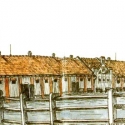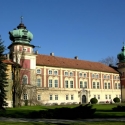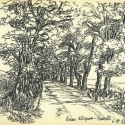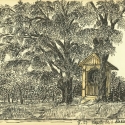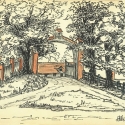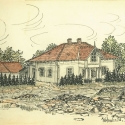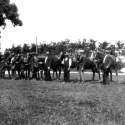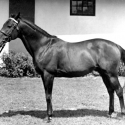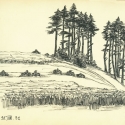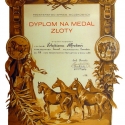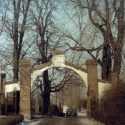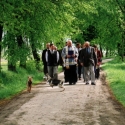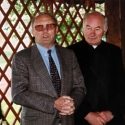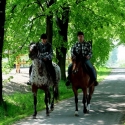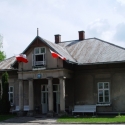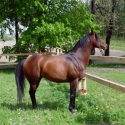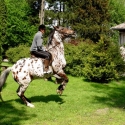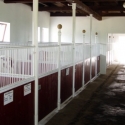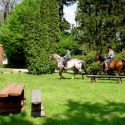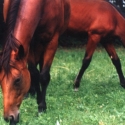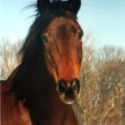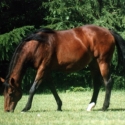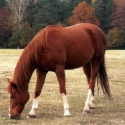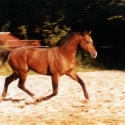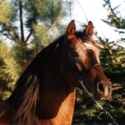The history of the stud till 1944
Albigowa is closely connected with the history of Łańcut and its owners. The Pilecki family ruled the town and the area from 1349 till 1578. The knight Otton from Pilcza, who named himself Pilecki was bestowed Łańcut and neighbouring villages by Polish king Casimir the Great. In the years 1578 - 1629 the owners were Stadniccy and then in years 1629 - 1816 Lubomirscy. After the death of Princess Elisabeth Lubomirska in 1816 extensive fortunes were received by her grandsons; Alfred and Arthur Potoccy. At first they ran the estate together, later after the partition of the property in 1822 the older Alfred received Łańcut and the neighborhood.
In 1830 he established Łańcut an entailed estate. The second heir in tail became his son Alfred Potocki (1822-1889).
A third heir in tail was Roman Potocki (1851-1915), a good and rich entailer. He owned 104 farms which area was about 50 thousand of hectares altogether.
Apart from that, he had coal-mines, brick-yards (the part of roofs on buildings in Albigowa is covered with tile from his brick-yard in Rawa Ruska), alcohol distilleries, liqueurs factories , gardens and palaces. He founded the stud of horses in Albigowa. He was a great expert of horses, which he loved. He managed the standard- stud, actively acted in horsemanship associations, organized horse race.
His younger brother Józef Mikołaj settled in Antoniny (district Zasław) their mother heritance. He owned one of the most splendid Arabian studs with horses descending from the old and precious Sławuta stud (the property of the Sanguszko family).
The world war and the Revolution in Russia destroyed completely the stud in Antoniny. This tragic time was commemorated in a sad poem "Śmierć Ibrahima".
Desert bred Ibrahim was the most splendid stallion bought in 1907 in Odessa. He was the father of the world famous Skowronek and the foundation sire of a very precious , active around the world Arabian sire line. Antoniny as well as other great Arabian studs: Sławuta and Białocerkiew ( the property of the Branicki family) were left outside Polish eastern border after World War I. Only one stallion and three mares survived from Antoniny. The mares gave rise to the newly established Potocki brothers' studs in Deraźne and Beheń.
The last heir in tail in Łańcut was Alfred III Potocki, the older son of Roman (1886-1958). In the twenties he developed the stud in Albigowa. The manager of the fortune became Konstanty Fangor, and later in years 1926-1932 a retired general of the army Filip Siarkiewicz.
Then he was replaced by his son-in-law Bolesław Orłoś, who worked earlier as an apprentice in Antoniny. He administered the stud until the encroachment of the Soviet Army. As lots of enlightened Poles, Bolesław Orłoś was deported to Siberia. The last heir in tail Alfred III avoided this fate leaving Łańcut on 23 July 1944.He went through Vienna to Lichtenstain and took along the best part of the most precious things.
In the interwar period the stud in Albigowa was one of the best in private hands. Horses from Albigowa won a lot of races taking a leading position in the winnings value of stakes. For 21 years of horse races Albigowa stud won the first place in years 1931(374050zł) and 1936 (285955zł), the second place in 1935 (257820zł), and the third places in years 1932(246400zł), 1933(253090zł), 1934 (203270zł).
Only horses from state studs achieved better results. Breeders received 10% of prize money as breeding bonuses. Two Derby winners Esson (1931) and Impet II (1935 ) were bred in Albigowa. Comparatively, the state studs bred 5 Derby winners. The most expensive English Throroughbred horse in the interwar period was "Łeb w Łeb" ("Neck and Neck"). He was bought to Albigowa in 1938 r by the count Alfred Potocki for 70 000 zlotys. This was one of the best stallions in the interwar period.
The most beautiful Arabian stallion was Khafifan bought in 1927 in Cairo from prince Mohammed Ali for huge amount of money - 400 thousand pounds sterling.
Unfortunately the sire disappointed completely in breeding.
Yearling horses from Albigowa were taken to the army by general Anders ( the later commander of Polish Army during World War II ). He had his own private racing stable in Albigowa. Albigowa was visited by many breeders including the Prince of Kent.
The history of the stud in years 1944 - 1966
Just after the end of acts of war in this area in 1944, the inspector of Breeding Horses in Lublin took Albigowa over and assigned it for a stud. English Thoroughbred mares as well as half-bred ones were gathered there. In 1946 the stud had 6 thoroughbred and 8 half-bred broodmares, including 5 horses which previously belonged to Alfred Potocki.
In 1947 the number of thoroughbred stud mares increased to 11. They were cared by Michał Holender the pre-war deputy manager of the Stallion's Depot in Sądowa Wisznia. In the autumn these mares were taken to Kozienice (thoroughbred) and to Skrzydlów (half-bred).
Albigowa was to be an Arabian stud. The manager became Kazimierz Małecki the pre-war officer of the cavalry - a very respectable man. The head groom was Józef Majchrzak, who had been working with horses all his life, unfortunately already stricken in years and in poor health - he died in autumn 1954.
Part of the grooms came from the Potocki stud which was perfectly managed in the interwar- period by general Siarkiewicz, and then Bolesław Orłoś. They were very disciplined and skilful employees.
The foundation of an Arabian stud in Albigowa was the most accurate response to the statement made by professor Jan Grabowski ( a well-known Polish hippologist).
"Arabian studs ought to be founded in regions which climate and soil, as long-standing experiences has proven, does not cause the gradual loss of the Arabian features in further generations".
It is commonly known that Arabian horse is the horse of the east and that it was best bred on the eastern borderland of Poland. Unfortunately, after the last war the eastern border of our country moved to the west, and consequently finding the suitable environment for pure-bred Arabs, became more and more difficult. It turned out that Albigowa has the proper habitat.
There is the continental climate: hot, dry years and severe winters. The soil is podzolic loess, in summer changing pastures into the concrete desert, which perfectly hardened tendons. In spring and autumn the sticky mud immunized fetlocks against all kinds of "cracked heels". Very strong winds blew all manner of germs away from the stables. So diseases of young horses ( provided that they were accustomed to the climate and their stables were disinfected regularly) happened very rarely and quickly passed without serious results. Albigowa did not have large area - 213 ha, including 14 ha of excellent meadows and 20 ha of pastures, which needed to be gradually renewed.
The soil was very fertile and , and the meadows produced a lot of perfect hay. Also a part of pastures and a little lucern field were designed for making hay . In sum, besides a few carriages of wheaten bran and in very dry years - several carriages of the rich in various herbs hay from Bieszczady, it was enough fodder and bedding for the livestock. (25-35 broodmares with young stock, 20 cows, 20 working horses and twenty several cows of workers).
Albigowa 's farm buildings were of rectangular shape, with the spaces between walled up with red The long walls of the rectangle were: one side the cow-shed, the stable for working horses, and a store for mineral manures , machines and other things. On the other side there were: a very long stable for pedigree horses (in general 40 boxes) and three little stables for young stock (with the room for up to 40 foals). In 1953 a new stable for colts was built outside the area of the rectangle.
In the middle of the yard there was a racing stable with boxes called "general Anders' stable" as the general had usually kept his race horses there in winter. The farm had two deep-water wells: one next to the cow-shed moved with the horse run and the second moved by 2-4 stablemen (then with an electric motor) which was situated in front of the pedigree stable.
The location of the farm itself was quite interesting. It looked as if inside a huge basin a small bowl was put upside down. On this bowl the farm buildings were situated.
Unfortunately the stud had little trees. They grew only at the entrance to the object , next to the dwelling house, also near the pedigree stable and along the way leading to the forester's house.
On 16 November 1947 the first pure-bred Arabs came to Albigowa from Nowy Dwór (4 mares). Then, two days later 16 mares with the young stock arrived from Posadowo . In 1948 2 mares came from Nowy Dwór and 3 mares from the racetrack.
On 1 January 1949 Albigowa had 25 mares bred in the following studs: JANÓW PODLASKI - 6 MARES.
Excellent:
- Wilga 1938 (Ofir - Jaskółka II) the mother of group of splendid mares with Carmen 1942 (by Trypolis)
- Ofirka 1938 (Ofir - Fryga II)- the mother of precious mares and stallion Orzeł 1963 (by Pietuszok) sold to the U.S.A.
- Canaria 1942 (Trypolis - Saga) the mother of perfect mares and stallions i.e. Celebes 1949 and Karmin 1952 sold to Germany (both by Witraż)
Much worse:
- Norma 1932 (Hardy - Freja) with the daughter :
- Sokora 1936 (Hardy - Halina) which gave only brave race horses - Semen 1956 (by Laur) won the Derby and the Criterium ( 2 times)
- Enorme 1944 (by Trypolis)
Unfortunately the two first broodmares could not do their best in Albigowa, as they were inbred several times running.
BABOLNA - 4 MARES
All four of them left their daughters in Albigowa. The most precious of them proved to be:
- Bulwa 1937 (Kuhailan Zaid - Siglavi Bagdady) the foundation mare of an excellent family, from which descend famous Algeria 1971 and Probat 1975. Therefore her contribution to Polish breeding is especially significant.
- Bona 1937 (Kuhailan Zaid - 23 Mersuch I) the mother of stallion Como.
Little worse in breeding, but taller and better in conformation were:
- Balia 1936 ( Kuhailan Zaid -25 Kemir) the mother of an excellent Boligord 1950 sold to Rumania and the precious mare Celia 1949
- Bryła (Kuhailan Zaid - 24 Koheilan IV).
In 1951 all four mares were returned to the National Stud in Babolna (Hungary).
UJAZD - 5 MARES
Excellent:
- Elza 1942 (Rasim Pierwszy - EI Zabibe)- the mother of splendid daughters (Celina 1949, Ellorra 1950 and Elżunia1951). A lot of contemporary stallions and mares descend from Elza.
- Rasima 1943 (Rasim Pierwszy - Sardhana) - founded a precious family through her granddaughter Złota Iwa 1958.
Considerably worse:
- Abuza 1935 (Fetysz - Fasila) with the daughter
- Rabda 1943 (by Rasim Pierwszy)
- Katona 1941 (Lowelas - Khamza)
PEŁKINIE - 6 MARES
Precious:
- Gahdar 1942 (Wielki Szlem - Gadila) the mother of stallion Abu Afas 1947
- Mira 1942 (Wielki Szlem - Hirfa) the mother of stallion Mir Said 1953
- Musailima 1942 (tWielki Szlem- Tęcza)
- Mlecha Pełkińska 1942 ( Wielki Szlem - Zorza Pełkińska)
Mussalima and Mlecha Pełkińska were only broodmares' dams of no value in breeding:
- Atszlemra 1944 (Wielki Szlem - Atfa)
- Buszlemra 1944 (Wielki Szlem - Bussorach).
In fact all of these mares did not play an important role in Albigowa.
DOBUŻEK _2 MARES
Precious:
- Karmen II 1937 (Koheilan I- Kasyda) the mother of excellent Karramba 1951 (by WItraż) and quite good Kreolka 1957 (by Nabor). Karramba was the best broodmare in Ms. Lindsay's stud in Great Britain. of inferior quality
- Kalja 1942 (Drop - Kaszma) which did not give anything valuable in Albigowa.
GUMNISKA -1 MARE
- Ferha 1943 (Kuhailan Abu Urkub - Udżda). She was a mare of extremely precious origin( three horses from two generations earlier were born in the desert). Apart from dryness she possessed no other desirable qualities and was not beautiful, although very feminine. She gave a stallion Faher 1953 (by Trypolis) and two daughters which unfortunately were not used in breeding.
KRAŚNICA -1 MARE
An excellent Bałałajka 1941 (Amurath Sahib Iwonka III). She was one of the most remarkable Polish broodmares, dam of stallions Banio 1951, Bej Assan 1953 (twice winner of the Criterium) and Bask 1963 (U.S. National Champion Stallion and immortal sire of champions in the U.S.A.) as well as splendid mares: Arfa 1947, Bandola 1958.
Bandola 1948 (Witraż - Bałałajka) grey. One of the most outstanding and most beautiful broodmares called "the Queen of Polish Arabs".
Bandola was as the beauty a little cocky. She liked to be admired. She bewitched looking at her with her own beauty. However, she had a very independent character and was too hot-tempered. Bandola was all the time a real individuality. Dashing, shaking her head negatively, tried always to do what she wanted to.
Although Bandola liked to be admired, she got bored quickly . She became impatient and it was difficult to photograph her when she was young. Later, she got accustomed to tributes and her character changed to advantage. Bandola represented her own, unique type. She showed more father' s features than mother's. As none Witraż daughter she combined great beauty with the calibre and arms. It seems that her strength, and great individuality proved her genetic potential and predisposed her for a mother of stallions.
In 1949 Albigowa had probably the most precious breeding material in Poland. From the racetrack successively came excellent Witraż's daughters out of Albigowa's mares, which raised the level of breeding stock of the stud.
In years 1948-1951 after completing performance tests on the racetrack 8 broodmares were incorporated into the stud.They were bred in the following studs:
PEŁKINIE 3 daughters of Wielki Szlem - of average quality Atszlemra 1944 and Buszlemra 1944 and much more precious Wielka Zorza (the mother of stallion Wiraż)
JANÓW PODLASKI - precious Arwila 1947 ( Amurath Sahib - Wilga), Arfa 1947 (Witraż - Bałałajka) who was born in Janów Podlaski, but was recorded as Kraśnica's stud foal and Gstronomia 1946, and of no value in breeding: Anomaly 1947 and Enorme 1944.
In December 1951 the mares bred in Babolna were returned to their mother stud in Hungary. In 1957 according to the scheme of exchange the following mares left the stud: to Michałów: Canaria 1942, Bint Canaria 1948 and Karmen II 1937 and to Nowy Dwór: Bryssaga 1950, Gastronomia 1946, Mussailima 1913, Rokiczana 1953 and Wielka Zorza 1945.
In 1956 two mares were bought from Tiersk stud: Pikirowka 1953 - eliminated from breeding in 1960 and splendid Piewica 1953 (Priboj Włodarka) which made a great contribution into Polish breeding, giving stallions and mares.
In 1957 five mares left (the number of broodmares was reduced) to the newly organized stud of the Institute of the Zootechnics in Rymanów. They were: Anomalia 1917, Córa Mlechy 1949, Bonita 1950, Orla 1951 and Femina 1952. Unfortunately in 1958 this stud was liquidated , and horses were sold on the auction on the market in Sanok . During the existence of this stud 15 chief sires more or less precious were used there.
The first stallion, which came to Albigowa from Posadowo together with mares was bay Witraż 1939 (Ofir - Makata). Dimensions 153-180-19. The horse of outstanding beauty and quality. He was a sturdy, well- sized horse with a wonderful head, eye, nostrils and ears and had a meaningful expression in his eyes. His neck was slightly thick, but very well shaped. He had well pronounced withers, and a slightly weak loin. He also had slightly knotted knee, which he often passed to his progeny. He stayed in Albigowa in years 1948-1955, in sum 8 mating seasons. He sired 18 excellent mares, of international class in Albigowa. Five of them gave as many as l0 chief sires. Several of Witraż sons were sold abroad.
The best of them was Bask 1956 ( out of Bałałajka) . He won numerous championships in the U.S.A.
He was also a sire of champions and was called "The Revelation of America".
In general in Albigowa Stud Arabian foals were born in 14 breeding seasons. Among them were 11 chief sires with a superb Celebes 1949 (Witraż-Canaria) and a very useful Faher 1953 (Trypolis -Ferha). Celebes was used in Polish breeding program after 14 years of circus career. He sired 14 stallions including Aloes 1973 and 44 excellent broodmares ( among them Algeria 1971. Ekstaza 1969, Mitra 1969).
Faher sired 5 stallions including El Azrak 1960 and 12 broodmares. Several precious mares including Bandola 1948, Celina 1949, Ellora 1950 (dam of El Azrak 1960 and El Paso 1967- U.S. National Champion Stallion), Etna 1959 ( dam of 5 stallions and 7 broodmares) and Penza 1959, were bred in Albigowa.
Horses from Albigowa won together 17 classical stakes: 6 times Derby, 5 times Oaks and 6 times Criterium. In 1953 the manager Casimir Małecki was dismissed on political grounds, and replaced by Joseph Jakubowski,who left to Kobylin in 1955. In years 1956-1960 the manager of Albigowa was Franciszek Mieszkowski, and then, after he retired Adamowi Niedziałkowskiemu.. He was the manager, until the liquidation of the Stud.
In summer 1961 Arabians from Albigowa were transferred to the State Studs in Janów Podlaski and Michałów (21 mares with offspring).
Arabians were replaced in by half-bred Furioso-Przedświt horses, which stayed there till 1966 , when the stud was liquidated, and the object ideal for horse breeding was assigned to the Institute of the Fruit-growing. On the premises of the former stud there was established one of the local departments of the Institute of the Fruit-growing in Skierniewice.
Mister Roman Pankiewicz was the breeding assistant in Albigowa in years 1951-1954 and the deputy manager in years 1955-1958. He proved to be an outstanding breeder and raised the standard of the stud into top-level.
The history of the stud in years 1966 - 1997
According to the administrative decision the State Stud in Albigowa was liquidated on 1 July 1966 , and the object ideal for the stud farm was assigned to the Institute of Fruit-growing in Skierniewice.
On the premises of the stud there was established one of departments of the Institute of Fruit-growing in Skierniewice. The stables were adapted for new needs losing irrevocably their original destination.
The history of the stud in years 1997 - 2003
In 1997 the Institute of Fruit-growing sold the Departament in Albigowa to Anthoni Dziugieł and Józef Bytnar.
On 16 November 2003 referring to "the historical date 16 November 1947", when the first Arabian horses were brought from Nowy Dwór and Posadowo", the decision of reactivating the Stud in Albigowa was made.
The stud was named "BASK - the Stud Farm Albigowa", in honour of the most famous stallion , the Champion of Champions, bred in Albigowa in 1956.
The reactivation of the stud
The solemn reactivation of the stud took place on 8 th May 2004. The former employees including the Orłoś family participated in this celebration.
The stud today
Today, after long lasting break in horse breeding , pure-bred Arabians and English Thoroughbreds can again be seen in Albigowa.
Mister Tadeusz Stasienko, the owner of the Mansion in Julin is the partner in reactivation and activity of the stud..


